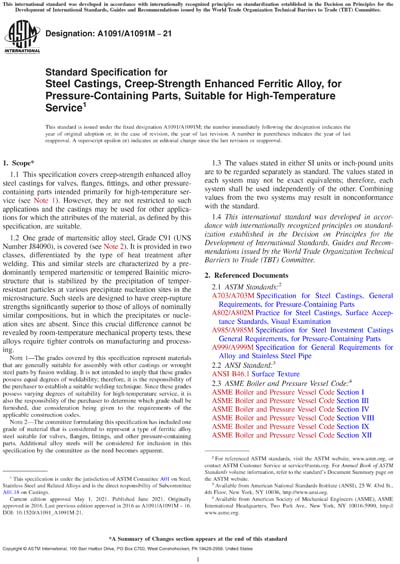Most recent
ASTM A1091/A1091M-21
Standard Specification for Steel Castings, Creep-Strength Enhanced Ferritic Alloy, for Pressure-Containing Parts, Suitable for High-Temperature Service
1.1This specification covers creep-strength enhanced alloy steel castings for valves, flanges, fittings, and other pressure-containing parts intended primarily for high-temperature service (see Note 1). However, they are not restricted to such applications and the castings may be used for other applications for which the attributes of the material, as defined by this specification, are suitable.
1.2One grade of martensitic alloy steel, Grade C91 (UNS Number J84090), is covered (see Note 2). It is provided in two classes, differentiated by the type of heat treatment after welding. This and similar steels are characterized by a predominantly tempered martensitic or tempered Bainitic microstructure that is stabilized by the precipitation of temper-resistant particles at various precipitate nucleation sites in the microstructure. Such steels are designed to have creep-rupture strengths significantly superior to those of alloys of nominally similar compositions, but in which the precipitates or nucleation sites are absent. Since this crucial difference cannot be revealed by room-temperature mechanical property tests, these alloys require tighter controls on manufacturing and processing.
Note 1:The grades covered by this specification represent materials that are generally suitable for assembly with other castings or wrought steel parts by fusion welding. It is not intended to imply that these grades possess equal degrees of weldability; therefore, it is the responsibility of the purchaser to establish a suitable welding technique. Since these grades possess varying degrees of suitability for high-temperature service, it is also the responsibility of the purchaser to determine which grade shall be furnished, due consideration being given to the requirements of the applicable construction codes.
Note 2:The committee formulating this specification has included one grade of material that is considered to represent a type of ferritic alloy steel suitable for valves, flanges, fittings, and other pressure-containing parts. Additional alloy steels will be considered for inclusion in this specification by the committee as the need becomes apparent.
1.3The values stated in either SI units or inch-pound units are to be regarded separately as standard. The values stated in each system may not be exact equivalents; therefore, each system shall be used independently of the other. Combining values from the two systems may result in nonconformance with the standard.
1.4This international standard was developed in accordance with internationally recognized principles on standardization established in the Decision on Principles for the Development of International Standards, Guides and Recommendations issued by the World Trade Organization Technical Barriers to Trade (TBT) Committee.
Content Provider
ASTM International [astm]






